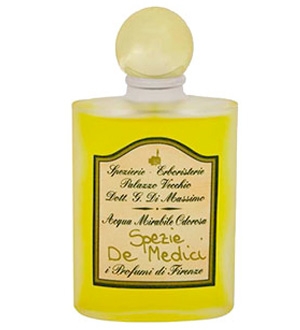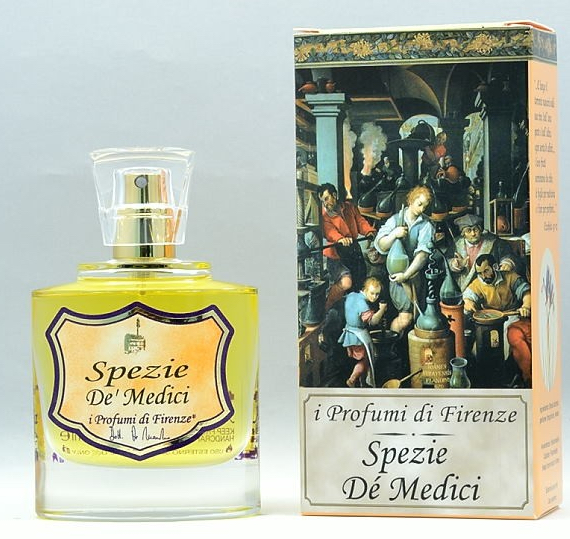I Profumi di Firenze Spezie dé Medici (1990): A Christmas Pomander from the Renaissance {Perfume Review & Musings}

Spezie dé Medici by I Profumi di Firenze, a niche fragrance house from Florence in Italy is not meant to be a Christmas perfume - unlike Nuit de Noël by Caron, or Parfum Sacré by Caron - but it ends up smelling to a contemporary nose like a spicy tea blend prepared for the Yule season.
The scent is said to be based on a signature Renaissance recipe favored by the Medici family and retrieved by perfumer-chemist Dr. Giovanni Di Massimo who recreated the perfume after the "Acqua degli Angeli " found in the illustrious albeit mostly forgotten by most perfumery tome from 1555, Notandissimi Secreti dell'arte Profumatoria...
Spices in that era were precious ingredients indicative of the wealth and status of the rich and noble who could afford them - and display them with ostentation. Spezie dé Medici concentrates at least 8 different spices, including vanilla, and many more essences. The perfumer explains,
"Thinking of the perfumers of the Renaissance and all the natural ingredients that they used for their art, I created a warm scent, pungent and stimulating by expertly mixing more than 40 different natural essential oils, which makes this fragrance rather rare. It is clearly a spicy very intense fragrance, that will certainly remain in the hearts of many of you for long."

Spices were also valued for their prophylactic properties. If today, we can appreciate this warm, sweet and spicy concoction in a different light, mainly because it feels chistmas-y in a gourmand manner, we can imagine that in the distant past, it would have smelled like gold, brocades and privilege.
The perfume Spices dé Medici is also fruity. It smells like a very juicy orange pomander studded with clove nails and rolled in cinnamon and red cayenne pepper powders. Oranges were rare as well and a sign of luxury. Bringing together the juiciness of the fruit and the dryness of spices, the composition maintains an unrealistic - in an admirable way - level of zesty freshness. But so it does. The orange literally glows with pulpy energy as if it had been turned inside out. The mingling of spices with the sweetness of vanilla and orange blossom evokes somehow chocolate and almond marzipan in the background. A certain hazy softness suggests orris powder and white chocolate, although no iris note is officially listed.

Catherine de Medicis
The fragrance which opened on a prolonged burst of winter orange gradually softens and becomes more of a spicy iris-y perfume which chocolatey accents. The main impression is very much iconic of gourmand Christmas smells, and in particular of Christmas tea blends. At one point you are reminded a bit of spicy perfumes like Rousse (cinnamon), Five O' Clock au Gingembre (ginger) by Serge Lutens and L by Lolita Lempicka. The perfume evokes yet another gourmand treat, gingerbread. You then learn of a rumour circulated in the times of Catherine de Medici, who had Italians transplanted from Florence in her entourage who were suspected of offering poisoned gingerbreads to their enemies. This turned off the French from the sweet bread until the end of the reign of Louis XIV.
As an iris-y scent, it is more original thanks to its pairing with orange which makes it less of a reflective, even sometimes melancholy powdery floral note. Gourmand irises however have become more of a genre, exploiting its affinities with chocolate. I am reminded that according to my experience, cinnamon has an iris-y, rooty facet. The base accentuates the soft, almondy facet of the scent, which starts to now smell of heliotrope - and chocolate again. There is also a hint of an old-school mossy base. The formula is rather simple and more like a real-world aromatic rendition of festive, or fastuous times.
Cosimo I de Medici
It is interesting to think that this is a Renaissance perfume in the sense that you could not have smelled such a bouquet of spices in the Middle Ages. In the 21st century of course we are spoiled and might not appreciate anymore how rare these ingredients were once - more expensive than gold. We can still appreciate their tonic properties, and I would say that Spezie dé Medici is not a calming, contemplative or soothing spicy perfume. Fired up with red cayenne, clove, ginger, cinnamon, nutmeg, but also pink and white pepper it makes you feel perfume-wise as if you were smelling the color red. The scent excites you almost unconsciously. You catch yourself thinking that those Medici people were quick to draw their daggers and had a well-deserved reputation for violence. Obviously, with such a regimen of hot spices, their temperament could only be over-stimulated, which they evidently saw advantage in cultivating.
Use with caution as when you need a boost. Use with caution also because the concentrated fragrance which I review here can provoke a rash on your skin if you're sensitive. Spices are attractive and even beguiling but they can be easily overdosed, in a medical sense.
Main notes: orange, lemon, ginger / orange blossom, cinnamon, nutmeg, cloves /Pink pepper, white pepper, vanilla from Madagascar










